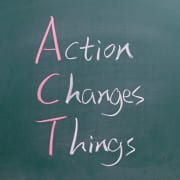The knowing/doing gap
I’ve been leveled by the flu this week. Whether it’s due to the resulting brain fog or a flash of insight (and if so, a flash probably triggered by David Maister’s Strategy and the Fat Smoker, which is still buzzing around in my head), I have been struck over and over by a single theme while reading up on recent law-related news: the huge gap that exists between knowing and doing. Just to select one example:
If you’ve ever considered hanging out a shingle, be sure to read A Conspiracy of One in this month’s ABA Journal. It’s the story of Michael Grossman, a former Cook County public defender who opened his own office in September 2007. It’s interesting to read about Grossman’s decision to start his own practice, and the article does a nice job of illustrating the challenges and benefits. And happily, as the update indicates, Grossman’s practice is growing and he’s pleased with his choices.
Where I saw the knowing/doing gap is in an accompanying article titled Pencil to Paper Prosperity, which sets out David Freeman’s five elements of a successful client development system. The five elements?
1. Identify your target market.
2. Reach your target market in the right way.
3. [Have a] contact management method.
4. Set goals.
5. Create a system or accountability.
These are excellent steps in a business development plan. They’re critical steps. And I hope they aren’t news to anyone who’s contemplated bringing in new business. Really, although some aspects of each step may bring new information, the steps themselves are something that we all know to do. And yet, a great many lawyers don’t actually do these things in a regular, systematized way. It’s a knowing/doing gap. Bridge that gap, and you’ll likely develop more business.
Bridging that gap requires making a commitment, which in turn often calls for devising a system for accountability. The huge numbers of demands on most lawyers’ time means that without some accountability, the least urgent tasks are likely to get left behind — and while there’s work yet to be performed, business development tasks may well be viewed an non-urgent. It’s important, then, to create a system that raises the urgency level, whether that’s maintaining a calendar and task list that includes the steps to which you’ve committed or whether it’s having a buddy, group, mentor, or coach with whom you check in periodically to provide updates, to troubleshoot, and to lay plans going forward.
If you’re interested in learning more about this gap, do read The Knowing-Doing Gap by Jeffrey Pfeffer and Bob Sutton. Although it explores the gap that exists in large organizations and how some organizations bridge it (think GE, Toyota, and the like), there’s useful information that is applicable by analogy.
Where is your knowing/doing gap? Is it around business development, skills enhancement, a necessary but not pressing career change, implementing time management strategies, or the way you balance your professional and personal responsibilities? Take a step today.



Leave a Reply
Want to join the discussion?Feel free to contribute!